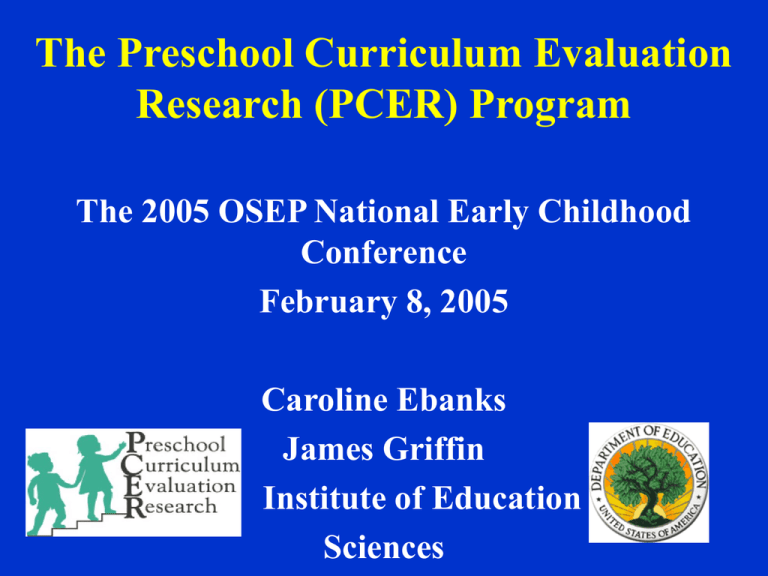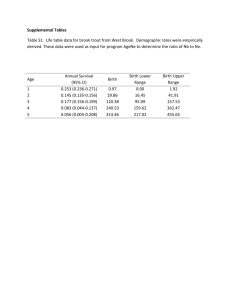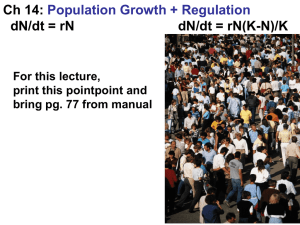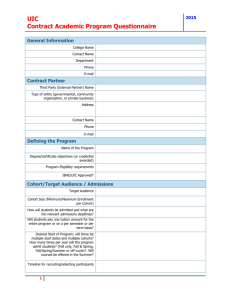Copy of OSEP Conference Presentation
advertisement

The Preschool Curriculum Evaluation Research (PCER) Program The 2005 OSEP National Early Childhood Conference February 8, 2005 Caroline Ebanks James Griffin Institute of Education Sciences Acknowledgements PCER 2002 and 2003 Researchers RTI PCER 2002 National Evaluation Coordinator Ina Wallace and Holly Rhodes Mathematica Policy Research PCER 2003 National Evaluation Coordinator John Love Institute of Education Sciences (IES) IES Statutory Mission • Condition and progress of education in the United States • Education practices that improve academic achievement & access to education opportunities • The effectiveness of Federal and other education programs Institute of Education Sciences Office of the Director National Board for Education Sciences National Center for Education Statistics National Center for Education Research National Center for Education Evaluation National Center for Special Education Research Preschool Curriculum Evaluation Research • Immediate Program Goals – Provide practitioners with evidence for selecting preschool curricula – Support rigorous evaluations of preschool curricula using random assignment • Additional Goals – Support complementary research studies to supplement the evaluation – Build capacity for collaboration between researchers and practitioners PCER: General Framework • Three year longitudinal studies across the transition from preschool to kindergarten and first grade • Grantees were funded to implement curricula and conduct complementary research studies at each project site • Focus on supporting school readiness, especially for disadvantaged children • Common core of evaluation data collected by an outside contractor Basic Design of Evaluation • Two groups of grantees (PCER 2002 and PCER 2003) implementing a variety of preschool curricula • Randomly assigned either schools, classrooms, or children to the treatment condition • Baseline and three follow-up assessments—end of preschool, end of kindergarten, and end of first grade Primary Research Questions • What outcomes do specific curricula produce? • Are outcomes sustained over time? Secondary Research Questions • What is the relationship between level of implementation and participation and curriculum effectiveness? • How are experiences in kindergarten and first grade related to child outcomes? PCER Project Cohorts IES Cohort 1: PCER 2002 National Evaluator: RTI 7 Grantees Cohort 2: PCER 2003 National Evaluator: MPR 5 Grantees Basic Design Features • 14 Experimental Curricula • 12 Grantees in 13 geographic locations -California -Florida -Georgia -Kansas -Missouri -New Hampshire -New Jersey -New York -North Carolina -Tennessee -Texas -Virginia -Wisconsin PCER Curricula • PCER 2002 Curricula • PCER 2003 Curricula – Bright Beginnings (TN) – Creative Curriculum (NH, NC,GA, TN) – Doors to Discovery (TX) – Early Literacy and Learning Model (ELLM) (FL) – Ladders to Literacy (NH) – Let’s Begin with the Letter People (TX) – Pre-K Mathematics with DLM Express Math (CA/NY) – Project Approach (WI) – Curiosity Corner (FL, NJ, KS) – The Language Focused Curriculum (VA) – Literacy Express (FL-FSU) – Open Court with DLM Early Childhood (FL-FSU) – Project Construct (MO) – Ready, Set, Leap! (Newark, NJ) PCER 2002 Cohort Grantee Research Site(s) Dale Farran Vanderbilt University Tennessee Cheryl Fountain University of North Florida Florida (Bay, Jacksonville, and Miami) Richard Lambert UNC Charlotte Georgia and North Carolina Susan Landry University of Texas Health Science Center, Houston Houston, Texas Doug Powell Purdue University Milwaukee, Wisconsin Jeff Priest University of New Hampshire New Hampshire Prentice Starkey University of California, Berkeley California and New York PCER 2002 Sites and Curricula Research Site Curriculum Tennessee Creative Curriculum vs. Bright Beginnings vs. Comparison Early Literacy and Learning Model vs. Comparison Creative Curriculum vs. Comparison Doors to Discovery vs. Let’s Begin with the Letter People vs. Comparison Project Approach vs. Comparison Creative Curriculum with Ladders to Literacy vs. Comparison Pre-K Mathematics vs. Comparison Florida North Carolina/Georgia Texas Wisconsin New Hampshire California/New York PCER 2003 Cohort Grantee Research Site(s) Bette Chambers Success for All Foundation Florida, Kansas, New Jersey Anne Cunningham University of California, Berkeley Laura Justice University of Virginia Newark, New Jersey Christopher Lonigan Florida State University Florida (Taylor and Leon counties) Kathy Thornburg University of Missouri Missouri Virginia (Culpeper and Wise counties) PCER 2003 Sites and Curricula Research Site Curriculum Florida, New Jersey, Kansas Curiosity Corner vs. Comparison Newark, New Jersey Ready, Set, Leap! vs. Comparison Virginia The Language Focused Curriculum vs. Comparison Florida Literacy Express vs. Open Court/DLM vs. Comparison Missouri Project Construct vs. Comparison Grantees’ Complementary Research • FSU (Chris Lonigan): Implementation of Open Court/DLM and Literacy Express • NC/GA (Richard Lambert): Implementation of Creative Curriculum, 4th edition • UNH (Jeff Priest): Implementation of Ladders to Literacy Cross-Site Study Sample Size • Total sample size – 2913 children and 317 classrooms • PCER 2002: – 1,686 Children and 180 Classrooms • PCER 2003: – 1,227 Children and 137 Classrooms Types of Measures in the Cross-Site Study • • • • • Child Assessments Classroom Observations Teacher interviews Teacher reports of child behavior Parent interviews Overview • • • • • Preschool program type Demographics Academic Outcomes Social Outcomes Teacher Characteristics Types of Preschool Programs in the PCER 2002 Cohort 6% 44% 50% Head Start Public School Private Pre-K Types of Preschool Programs in the PCER 2003 Cohort 23% 12% Head Start Public School Private Pre-K 65% Demographics From the Parent Interview Children’s Age (in years) 5 4.5 Treatment Control 4 2002 Cohort 2003 Cohort Children’s Gender (% Male) 80 70 60 50 40 30 Treatment Control 20 10 2002 Cohort 2003 Cohort Race/Ethnicity 100% 80% 60% 40% 20% 0% 2002 White (non-Hispanic) 2003 African American Hispanic/Latino Other Disability Status (% Yes) (Parent report) 35 30 25 20 15 Treatment Control 10 5 2002 Cohort 2003 Cohort Maternal Employment Status 100% 80% 60% 40% 20% 0% 2002 2003 Other Not Working Part-Time Full-Time Maternal Educational Level 60% 50% 40% 30% PCER 2002 PCER 2003 20% 10% 0% < HS HS Some post HS BA or higher Sample Comparisons: Poverty Indicators 60% 50% 40% PCER 2002 PCER 2003 FACES ECLS-K 30% 20% 10% 0% Medicaid (Child) AFDC/TANF PCER Sample Comparisons-Child PCER 2002 PCER 2003 FACES 53% 48% 51% 50% -White (non Hispanic) 30% 36% 31% 57% -African American (nonHispanic) 44% 52% 26% 14% -Asian/Pacific Islander 2% 1% 1% 7% -Hispanic/Latino 17% 5% 30% 18% 0.4% 1% 2% 2% 6% 6% 18% 3% 15% 19% 9% Gender (% Male) ECLS-K Race/Ethnicity -American Indian/Eskimo -Other Disability Status -- Teacher Education 100% 80% 60% 40% BA/BS or > < BA/BS HS or less 20% 0% 2002 Treatment 2003 Control 2003 Treatment 2003 Control Academic Outcomes From the Child Assessment -Baseline Data- Child Math Assessment (CMA) Composite 0.5 0.45 0.4 0.35 0.3 0.25 2002 Cohort 2003 Cohort Child Math Assessment (CMA) Composite score, by treatment status 0.5 0.45 0.4 0.35 0.3 0.25 0.2 0.15 0.1 0.05 0 Treatment Control PCER 2002 PCER2003 Woodcock Johnson-III: Applied Problems 100 95 90 85 80 2002 Cohort 2003 Cohort Woodcock Johnson-III: Applied Problems, by treatment status 100 95 Treatment Control 90 85 80 PCER 2002 PCER 2003 Test of Early Reading Ability (TERA): Reading Quotient 100 95 90 85 80 2002 Cohort 2003 Cohort Test of Early Reading Ability (TERA): Reading Quotient, by treatment status 100 95 Treatment Control 90 85 80 PCER 2002 PCER 2003 Woodcock-Johnson-III: Letter Word Identification 105 100 95 90 2002 Cohort 2003 Cohort Woodcock-Johnson-III: Letter Word Identification, by treatment status 102 100 98 Treatment Control 96 94 92 90 PCER 2002 PCER 2003 Woodcock-Johnson-III: Spelling 100 95 90 85 2002 Cohort 2003 Cohort Woodcock-Johnson-III: Spelling, by treatment status 100 95 Treatment Control 90 85 80 PCER 2002 PCER 2003 Peabody Picture Vocabulary Test (PPVT) III 95 90 85 80 2002 Cohort 2003 Cohort Peabody Picture Vocabulary Test (PPVT) III, by treatment status 100 95 Treatment Control 90 85 80 PCER 2002 PCER 2003 Test of Language Development (TOLD): Grammatical Understanding 10 9 8 7 6 5 2002 Cohort 2003 Cohort TOLD: Grammatical Understanding, by treatment status 10 9 8 Treatment Control 7 6 5 PCER 2002 PCER 2003 Social Outcomes From Teacher Report Form -Baseline Data- Social Skills Rating System (SSRS): Social Skills 105 100 95 90 2002 Cohort 2003 Cohort Social Skills Rating System (SSRS): Social Skills, by treatment status 105 100 Treatment Control 95 90 PCER 2002 PCER 2003 SSRS: Problem Behaviors 105 100 95 90 2002 Cohort 2003 Cohort SSRS: Problem Behaviors, by treatment status 105 100 Treatment Control 95 90 PCER 2002 PCER 2003 Preschool Learning Behaviors Scale (PLBS) 55 53 51 49 47 45 2002 Cohort 2003 Cohort Preschool Learning Behaviors Scale (PLBS), by treatment status 55 53 51 Treatment Control 49 47 45 PCER 2002 PCER 2003 What we can learn from PCER • Which curricula appear to better support school readiness • The type of support teachers need in order to effectively implement curricula Additional Benefits of PCER • Support collaboration between practitioners and researchers which can produce: – Research that is more relevant to practice – Researchers and practitioners who understand how to be good collaborating partners – Model for other education research programs PCER: Contact Information • Program Officers: – Caroline Ebanks, PhD E-mail: Caroline.Ebanks@ed.gov – James Griffin, PhD E-mail: James.Griffin@ed.gov • PCER Websites: – PCER 2002: http://pcer.rti.org/ – PCER 2003: www.pcer-mpr.info




